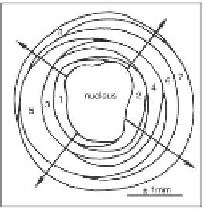Geology Reference
In-Depth Information
Plate 126 Standard Microfacies Types: SMF 26
Figs. 1 and 2 of this plate show a SMF Type introduced here. Main criteria are abundant calcareous pisoids/
vadoids (see Sect. 4.2.6), formed by early diagenetic meteoric carbonate precipitation, predominantly but not
always, during phases of subaerial exposure (-> 2). This microfacies is abundant in humid and tropical settings,
e.g. paleokarst limestones, caliche carbonates, and travertines. It is associated with SMF 9A in evaporitic set-
tings (FZ 9B). Pictures 3 and 4 on this plate show non-carbonate pisolitic structures.
Additional pictures:
Pl. 14/
1, Pl. 14/3, Pl. 34/6, Pl. 128/6.
SMF 26. Pisoid cementstones, rudstones and packstones
Criteria
: Accumulations of pisoids both autochthonous or allochthonous characterize this important facies-
diagnostic SMF Type. Diagnostic criteria are variously shaped, millimeter- to centimeter-sized, densely packed
pisoids, commonly cemented by meteoric cements. The cores of the pisoids are usually broken pisoids or cement
crusts. Reworking and redeposition is common. Many pisoids are inversely graded, exhibit polygonal fitting,
and are associated with tepee structures. Indigenous biota are usually lacking.
Occurrence
: Terrestrial subaerial,
or terrestrial and transitional terrestrial-marine subaquatic settings, formed under meteoric-vadose and marine-
vadose conditions (FZ 10).
1
SMF 26.
Pisoid rudstone.
These pisoids are the grains described in the classical paper by Dunham (1969; see Sect. 4.2.6
and Pl. 14/1) and interpreted as caliche soil pisoids formed by subaerial vadose diagenesis during episodic lowstands of
sea level. At present, the range of depositional interpretations of these pisoids includes caliche formation in continental or
coastal-spray-zone supratidal settings, vadose-marine inorganic precipitation in inter- and subtidal environments or for-
mation in marine seepage or groundwater springs (Handford et al. 1984). The pisolitic cementstone consists of large
pisoids/vadoids linked by outer laminae and meniscus cement. Most pisoids are well-laminated, their cortices consist of
accretionary, essentially isopachous cement laminae. The non-skeletal nuclei are preexisting pisoids or peloids. Arrows
point to vadose cements. Successive laminae differ in thinner darker micritic and clearer microspar lamellae. Most black
nuclei are broken fragments of preexisting pisoids. White nuclei correspond to reworked pieces of laminated interpisoid
cement. Late Permian (Carlsbad Group, Guadalupian): Entrance to the Carlsbad Cavern, New Mexico, U.S.A.
2
SMF 26.
Vadose pisolitic crusts
indicating cyclic exposure of lagoonal carbonates. The thin section displays inversely
graded pisoids (also called vadoids because of their formation within vadose diagenetic environments) made of pisoid
fragments, which in turn are cores of younger vadoids (V). Some vadoids exhibit radial cracks (RC), indicating sporadic
desiccation. The pisoids originated during subaerial exposure phases of parts of intertidal and shallow subtidal lagoonal
sediments in the back of platform-margin sponge-coral reefs. The pisolitic crusts may form beds reaching a thickness of
tens of centimeters to a few meters. Middle Triassic (Wetterstein limestone, Ladinian): Scharnkopf near Reichenhall,
Northern Calcareous Alps, Germany.
Non-carbonate pisoids
3
Silicified pisolite breccia.
Cretaceous: Subsurface. Ras Al Khaimah, United Arabian Emirates.
4
Pedogenic pisoids.
Pisoids occur both in carbonate and non-carbonate rocks. The sample is a lateritic pisolite representing
a pedogenic sediment. The pisoids have a diameter up to 5 mm and consist of a kaolinitic or pisolitic core and a cortex
composed of iron oxide. Note the shrinkage cracks within the cores (arrows). The matrix consists of hematite (black) and
kaolinite (white) representing reworked material of a weathered Precambrian basement (crystalline rocks). Sedimentary
structures indicate mass-wasting and fluviatile transport mechanisms. Late Cretaceous (Nubian Group): Wadi Kalabsha
southwest of Assuan, Egypt.
-> 2: Henrich 1984; 4: Fischer and Germann 1987
A
B
Fig. 14.27.
Genetically different pisoids differ in their morphology.
A
: Phreatic-vadose pisoids often exhibit irregular shapes,
polygonal fitting, abundant laminae and downward bulging.
B:
Caliche pisoids are characterized by centrifugal and accretional
growth, and a few discontiuous laminae. A: Modified from Esteban and Pray 1983. B: After Calvet and Julia 1983.


